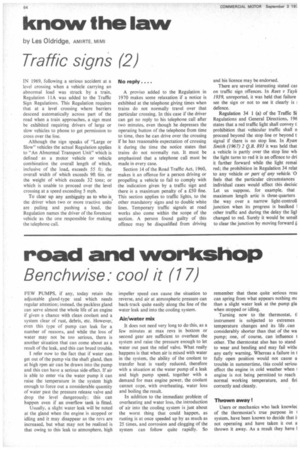know the law
Page 66

If you've noticed an error in this article please click here to report it so we can fix it.
by Les Oldridge, AMIRTE, IvIIMI
Traffic signs (2)
IN 1969, following a serious accident at a level crossing when a vehicle carrying an abnormal load was struck by a train, Regulation 11A was added to the Traffic Sign Regulations. This Regulation requires that at a level crossing where barriers descend automatically across part of the road when a train approaches, a sign must be exhibited requiring drivers of large or slow vehicles to phone to get permission to cross over the line.
Although the sign speaks of "Large or Slow" vehicles the actual Regulation applies to "An Abnormal Transport Unit" which is defined as a motor vehicle or vehicle combination the overall length of which, inclusive of the load, exceeds 55 It; the overall width of which exceeds 9ft 6in. or the weight of which exceeds 32 tons; or which is unable to proceed over the level crossing at a speed exceeding 5 mph.
To clear up any ambiguity as to who is the driver when two or more tractive units are pulling and pushing a load, the Regulation names the driver of the foremost vehicle as the one responsible for making the telephone call.
No reply. ....
A proviso added to the Regulation in 1970 makes some relaxation if a notice is exhibited at the telephone giving times when trains do not normally travel over that particular crossing. In this case if the driver can get no reply to his telephone call after two minutes, even though he depresses the operating button of the telephone from time to time, then he can drive over the crossing if he has reasonable expectation of crossing it during the time the notice states that trains do not normally run. It must be emphasized that a telephone call must he made in every case.
Section 14 of the Road Traffic Act, 1960, makes it an offence for a person driving or propelling a vehicle to fail to comply with the indication given by a traffic sign and there is a maximum penalty of a £50 fine. This section applies to traffic lights, to the other mandatory signs and to double white lines. Temporary traffic signals at road works also come within the scope of the section. A person found guilty of this offence may be disqualified from driving and his licence may be endorsed.
There are several interesting stated cas on traffic sign offences. In Rees. v Tayk 1939, unreported, it was held that failure see the sign or not to see it clearly is i defence.
Regulation 34 1 (a) of the Traffic Si Regulations and General Directions, 196 states that a red traffic light shall convey ti prohibition that vehicular traffic shall n proceed beyond the stop line or beyond t' signal if there is no stop line. In Ryan Smith (1967) 2 Q.B. 893 it was held that a vehicle is partly over the stop line wh the light turns to red it is an offence to dri it farther forward while the light remai red; the prohibition in Regulation 34 relat to any vehicle or part of any vehicle. 0 feels that the particular circumstances individual cases would affect this decisic Let us suppose, for example, that maximum length artic is three-quarters the way over a narrow light-controll junction when its progress is baulked 1 other traffic and during the delay the ligl changed to red. Surely it would be sensit to clear the junction by moving forward










































































































































